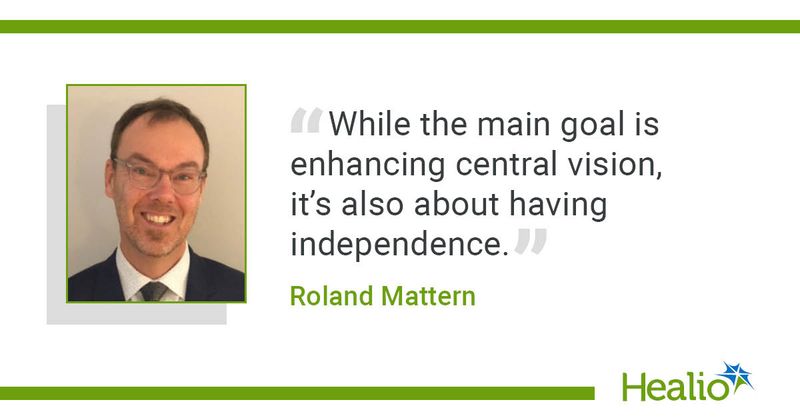Q&A: Look to assistive eye wear to boost independence during Healthy Aging Month
Key takeaways:
- Pathology and visual goals are the top considerations when determining which assistive technology to use.
- Modern assistive eye wear is more subtle and lightweight.
September is Healthy Aging Month, which the National Institute on Aging has celebrated by highlighting scientific innovations that help older adults remain independent as they age.
According to the National Eye Institute, although older adults are at increased risk for eye diseases such as age-related macular degeneration, vision loss does not have to be a part of getting older.

One option for patients with vision loss may be assistive eye wear technology, Roland Mattern, the company’s director of sales, told Healio. Here, he discusses how it can help aging patients with vision loss.
Healio: What eye conditions are associated with older age and how can assistive eye wear help people with those conditions?
Mattern: There are quite a number of pathologies that can impact vision as we age. The two big ones are age-related macular degeneration and diabetic retinopathy. Glaucoma is also a disease that can rob you of your peripheral vision, and you lose it from the outside in, whereas diabetic retinopathy and AMD rob you of your central vision. That has the faster impact because if you lose your vision centrally, then you may struggle to see faces, read, and watch TV or sporting events. If you lose vision from the periphery, you often do not perceive the vision loss immediately. AMD and diabetic retinopathy are probably the two biggest and fastest growing pathologies that people face in aging.
There are a number of ways to approach vision loss. For individuals who have lost central perception, we can take a wearable assistive device that uses cameras, software and OLED screens to give that perception back. We’ve been clinically demonstrated to show seven lines of distant visual gain.
This technology allows users to be able to read, recognize faces, play cards, pursue hobbies or watch TV, and we do all this without impeding the peripheral vision, so you can be mobile with these devices as well. That lends itself to independence. While the main goal is enhancing central vision, it’s also about having independence.
Healio: What are some recent advances in assistive technology that can help older patients?
Mattern: Augmented reality products are certainly on the cutting edge right now. We are using the best camera systems, autofocus systems, image stabilizations and all those types of technologies to optimize the image for the person wearing an assistive device.
Down the road, you might see AI potentially playing a role as well, where devices can learn your patterns, learn what settings you use for the type of situations you’re in and perhaps automate some of that for the individual to optimize the use of the product. We are still a bit away from that, but it certainly is promising.
We often heard, “This device works for me, but I’m reluctant to wear it in public because it draws so much attention to me, and I don’t want that.” As technology marches on, things get smaller and lighter and more powerful. This technology is no different. We have worked very hard in the design process to take all that weight and bulk out of the design, so we’re getting down to a form factor that resembles a big pair of sunglasses vs. a halo design with a visor. It’s much more subtle.
We have also taken the battery out of the headset and put it around the neck, so that takes a lot of weight out of the design. Now we have a wearable assistive device that is a third of the weight with better image processing, stabilization and autofocus and is easier to use in a smaller package. The more accessible a device is, the more people will be willing to take advantage of it.
Healio: What considerations should clinicians have when evaluating which technologies might be most helpful for their patients?
Mattern: Pathology plays a role. Is the pathology impacting peripheral vision? Is it impacting central vision? Determining what type of technology best lends itself relies on the disease state, the pathology and that patient’s progression. That is probably the No. 1 factor.
No. 2 is: What works for the patient’s goals? If a patient just wants to be able to sit and read a book, you may offer a different technology vs. somebody who wants to be active, be outside and garden, watch TV, read a book or see the grandkids.
References:
- Healthy Aging Month 2024: Shaping the future of aging. https://www.nia.nih.gov/news/healthy-aging-month-2024-shaping-future-aging. Published Sept. 1, 2024. Accessed Sept. 26, 2024.
- September is Healthy Aging Month. https://www.nei.nih.gov/learn-about-eye-health/outreach-resources/vision-and-aging-resources/healthy-aging-month. Accessed Sept. 26, 2024.
- Wittich W, et al. Optom Vis Sci. 2018;doi:10.1097/OPX.0000000000001262.
For more information:
Roland Mattern is director of sales and marketing at eSight.
